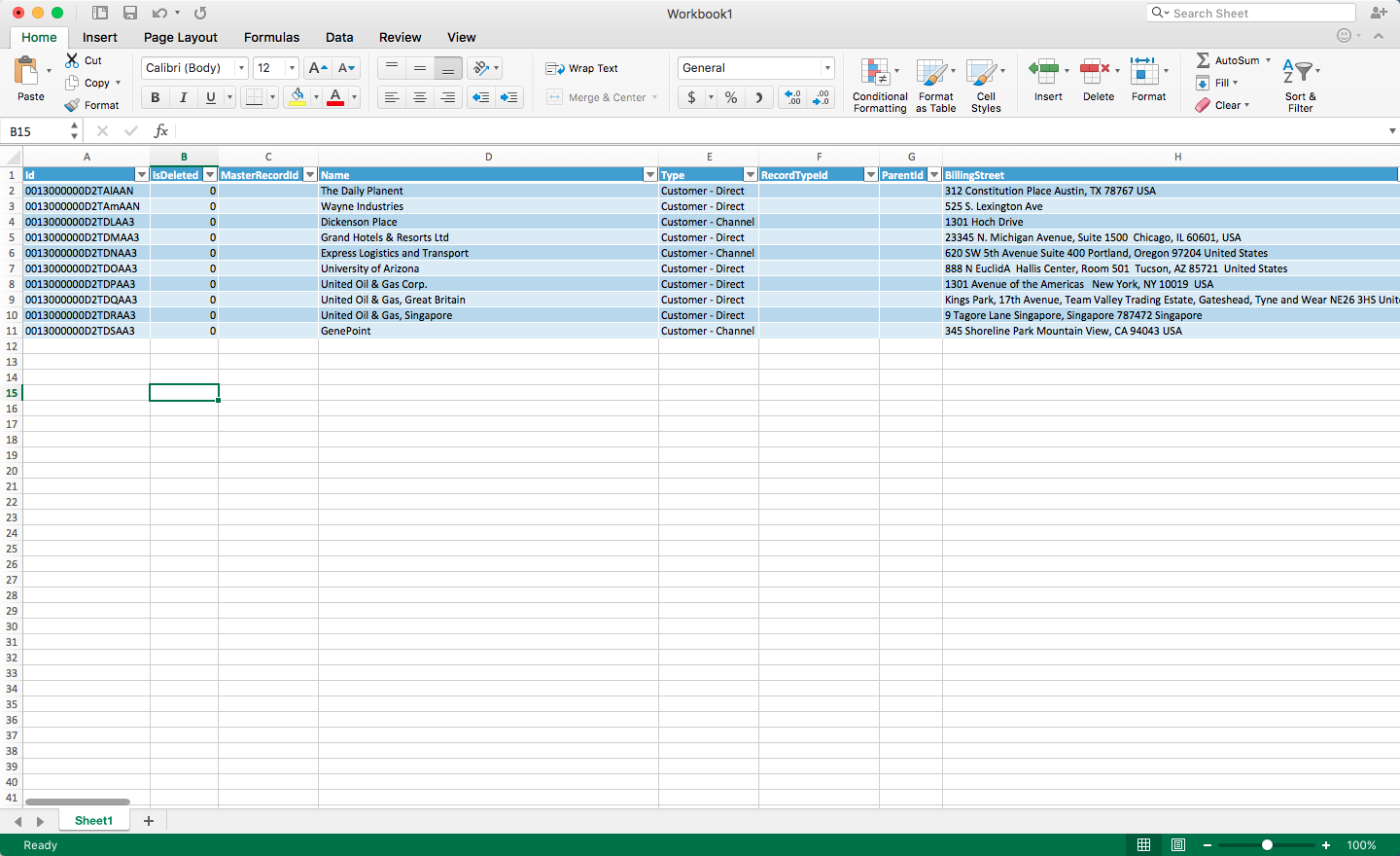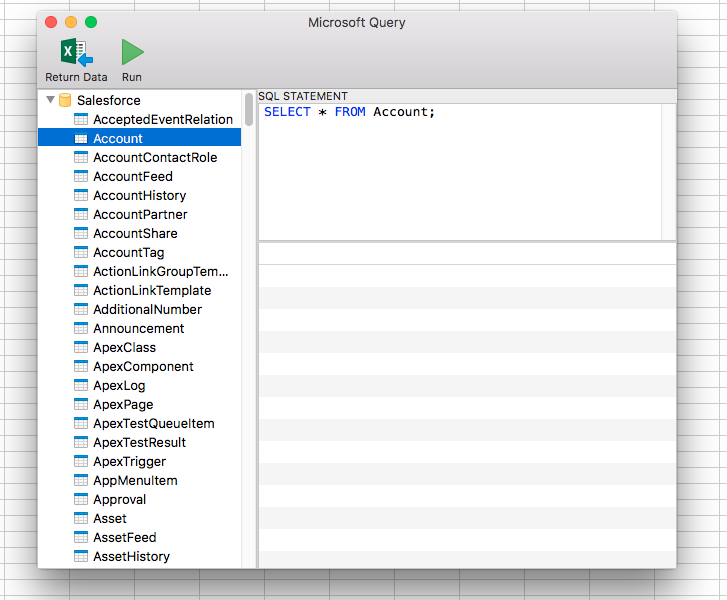Discover how a bimodal integration strategy can address the major data management challenges facing your organization today.
Get the Report →How to connect to Zuora Data from MS Excel on Mac OS X
Create a Data Source Name in iODBC with the CData ODBC Driver for Zuora and work with Zuora data in Microsoft Excel on Mac OS X.
Microsoft Excel features calculations, graphing tools, pivot tables, and a macro programming language that allows users to work with data in many of the ways that suit their needs, whether on a Windows machine or a Macintosh machine. This article walks through creating a DSN for Zuora data in iODBC and accessing Zuora data in Microsoft Excel, all on a machine running Mac OS X.
Installing the CData ODBC Drivers on Mac OS X
The CData ODBC Driver for Zuora is preconfigured for the iODBC driver manager, as are many other products like Microsoft Excel. This makes the driver easy to use with these tools.
Licensing the Driver
In a terminal run the following commands to license the driver. To activate a trial license, omit the key input.
cd "/Applications/CData ODBC Driver for Zuora/bin" sudo ./install-license <key>
Defining a DSN for iODBC with odbc.ini
You can define ODBC data sources in sections in the odbc.ini file. User data sources can only be accessed by the user account whose home folder the odbc.ini is located in. System data sources can be accessed by all users. You can find the correct odbc.ini in the following paths:
| Privileges | Path | |
|---|---|---|
| User | /Users/myuser/Library/ODBC/odbc.ini | |
| System | /Library/ODBC/odbc.ini |
Modifying iODBC's system-wide settings requires elevated permissions; to do so, you can use following to open a text editor from the terminal:
sudo nano /Library/ODBC/odbc.ini
Zuora uses the OAuth standard to authenticate users. See the online Help documentation for a full OAuth authentication guide.
Configuring Tenant property
In order to create a valid connection with the provider you need to choose one of the Tenant values (USProduction by default) which matches your account configuration. The following is a list with the available options:
- USProduction: Requests sent to https://rest.zuora.com.
- USAPISandbox: Requests sent to https://rest.apisandbox.zuora.com"
- USPerformanceTest: Requests sent to https://rest.pt1.zuora.com"
- EUProduction: Requests sent to https://rest.eu.zuora.com"
- EUSandbox: Requests sent to https://rest.sandbox.eu.zuora.com"
Selecting a Zuora Service
Two Zuora services are available: Data Query and AQuA API. By default ZuoraService is set to AQuADataExport.
DataQuery
The Data Query feature enables you to export data from your Zuora tenant by performing asynchronous, read-only SQL queries. We recommend to use this service for quick lightweight SQL queries.
Limitations- The maximum number of input records per table after filters have been applied: 1,000,000
- The maximum number of output records: 100,000
- The maximum number of simultaneous queries submitted for execution per tenant: 5
- The maximum number of queued queries submitted for execution after reaching the limitation of simultaneous queries per tenant: 10
- The maximum processing time for each query in hours: 1
- The maximum size of memory allocated to each query in GB: 2
- The maximum number of indices when using Index Join, in other words, the maximum number of records being returned by the left table based on the unique value used in the WHERE clause when using Index Join: 20,000
AQuADataExport
AQuA API export is designed to export all the records for all the objects ( tables ). AQuA query jobs have the following limitations:
Limitations- If a query in an AQuA job is executed longer than 8 hours, this job will be killed automatically.
- The killed AQuA job can be retried three times before returned as failed.
When you configure the DSN, you may also want to set the Max Rows connection property. This will limit the number of rows returned, which is especially helpful for improving performance when designing reports and visualizations.
In addition to the connection properties required to connect to Zuora, the Driver property specifies either a driver definition in the odbcinst.ini file or the path to the driver library. Place your connection properties at the beginning of odbc.ini:
[CData Zuora Sources] Driver = CData ODBC Driver for Zuora OAuthClientID = MyOAuthClientId OAuthClientSecret = MyOAuthClientSecret Tenant = USProduction ZuoraService = DataQuery
If you wish to authenticate using OAuth, you will need to add an additional connection property to ensure that the OAuth flow can execute properly:
Other = CheckPromptMode=False
Mac OS validates our drivers separately so you need to copy the license file to the appropriate path as well. After you have configured odbc.ini, run the following command.
sudo cp /Applications/CData ODBC Driver for Zuora/lib/CData.ODBC.Zuora.lic /Users/<YOUR_USER>/Library/Containers/com.microsoft.Excel/Data/.cdata/
Additionally, in the ODBC Data Sources section, the DSN must be set to a driver defined in the odbcinst.ini file. For example, below is the entry for the DSN created during the driver install:
[ODBC Data Sources]
CData Zuora Source = CData ODBC Driver for Zuora
Registering a DSN for iODBC with odbcinst.ini
You may need to modify the installed driver definition if you change the path to the driver library. To register an ODBC driver, modify the odbcinst.ini file. With iODBC, drivers can be available to only one user account or drivers can be available system wide. You can find the correct odbcinst.ini in the following paths:
| Privileges | Path | |
|---|---|---|
| User | /Users/myuser/Library/ODBC/odbcinst.ini | |
| System | /Library/ODBC/odbcinst.ini |
Drivers are defined in sections in the odbcinst.ini file. The section name specifies the name of the driver. In this section, the Driver property specifies the path to the driver library. The driver library is the .dylib file located in the lib subfolder of the installation directory, by default in /Applications/CData ODBC Driver for Zuora.
[CData ODBC Driver for Zuora]
Driver = /Applications/CData ODBC Driver for Zuora/lib/libzuora.odbc.dylib
The ODBC Drivers section must also contain a property with the driver name, set to "Installed".
[ODBC Drivers]
CData ODBC Driver for Zuora = Installed
Testing the Connection
You can test your connection using the iODBC administrator.
- Open a terminal and enter the following command to start the iODBC Administrator with the necessary permissions:
sudo /Applications/iODBC/iODBC\ Administrator64.app/Contents/MacOS/iODBC\ Administrator64
- On the Users tab, select CData Zuora Source.
- Click the Test button.
Accessing Zuora Data from Microsoft Excel
You can use the DSN configured above to access Zuora data from Microsoft Excel.
- Open Microsoft Excel and open a spreadsheet (new or existing).
- Navigate to the data ribbon and select New Database Query From Database
- Select the User or System DSN that you previously configured and click OK.
![Choosing the DSN (Salesforce is shown.)]()
- Build your SQL query in the Microsoft Query wizard:
![Querying for data (Salesforce is shown.)]()
- Click Return Data to execute the query and pull data into Excel.

Using the CData ODBC Driver for Zuora, you can easily pull your Zuora data directly into Excel. Once there, you can leverage all of the powerful features native to Excel to analyze, report, transform your Zuora data, and more!








